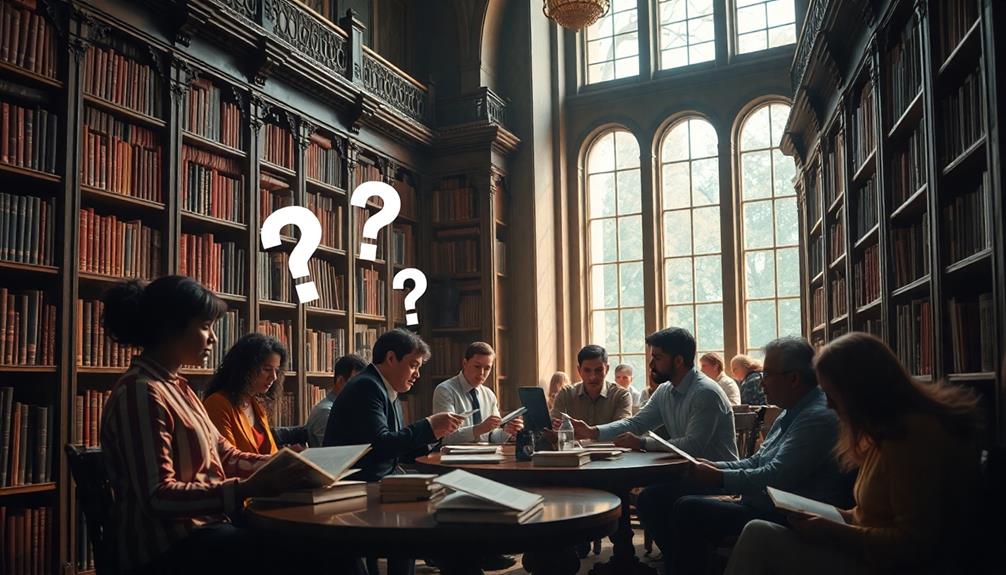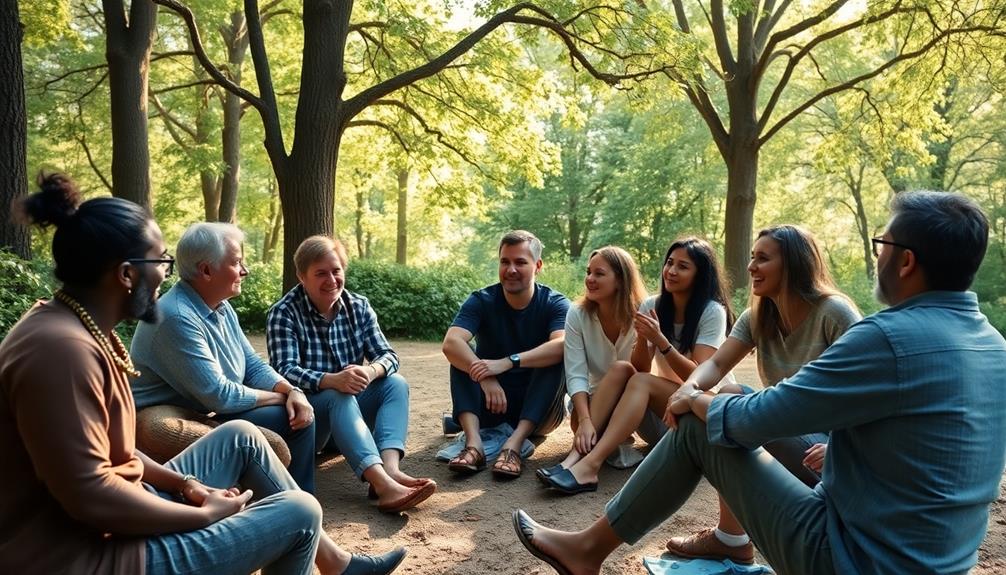The art of asking questions is all about revealing curiosity and deeper understanding. By focusing on open-ended questions, you can spark richer discussions and discover innovative solutions. Techniques like probing and clarifying help you dig deeper into conversations. Don't forget the power of active listening and empathy, which transform simple exchanges into meaningful dialogues. Overcoming barriers like fear of judgment can make questioning a habit, fostering a culture of inquiry around you. As you practice these skills, you'll find new ways to expand your thinking and insights; there's so much more you can explore further.
Key Takeaways
- Open-ended questions foster deeper discussions and insights, encouraging a mindset of curiosity and exploration.
- Active listening and empathy enhance conversations, creating an engaging environment for inquiry.
- Regularly challenging established beliefs promotes innovative thinking and personal growth.
- Overcoming barriers to curiosity involves embracing vulnerability and dedicating time for reflection.
- Creating a culture of inquiry encourages diverse perspectives and richer dialogues within teams and communities.
Understanding the Importance of Questions

Recognizing the power of questions can transform the way you approach problem-solving. Questions serve as a powerful tool that helps you identify core issues and explore effective solutions. The quality of your questions directly impacts your decision-making. When you craft well-thought-out inquiries, you can weigh options and understand potential outcomes more clearly.
For instance, consider how AI develops cures for common health issues by asking fundamental questions about disease mechanisms.
Open-ended questions encourage deeper insights and richer discussions, nudging you to explore ideas beyond surface-level responses. By engaging in inquiry, you foster a mindset of lifelong learning. This practice not only cultivates curiosity but also encourages your ongoing personal and professional development.
Think about how historical innovations originated from simple yet profound questions that challenged the status quo. These inquiries inspired creative solutions that shaped the world.
Types of Questions to Ask

Asking the right questions is key to revealing deeper conversations and insights. To truly harness the power of curiosity, you need to understand different types of questions you can ask.
Each type serves a unique purpose in fostering dialogue and enriching discussions, much like how nighttime meditation can enhance mental clarity and relaxation.
Here's a breakdown of effective question types:
- Closed-ended questions: Yield specific answers, often limiting depth.
- Open-ended questions: Encourage elaborate responses, promoting exploration.
- Probing questions: Uncover deeper opinions and motivations, leading to richer insights.
- Clarifying questions: Guarantee everyone shares a common understanding of the topic.
- Reflective questions: Help participants think critically about their responses.
Techniques for Effective Inquiry

Curiosity thrives on effective inquiry, and mastering the art of questioning can transform conversations. To dive deeper into discussions, focus on asking open-ended questions. These kinds of questions encourage exploration beyond simple yes or no answers, allowing for richer dialogue.
Additionally, understanding the nuances of emotional connection can enhance the depth of your inquiries, as seen in relationships where communication plays a vital role, such as when maneuvering the time apart that spells relationship doom. You should also incorporate probing and clarifying questions, which help uncover deeper opinions and guarantee everyone shares a common understanding.
The way you phrase your questions matters greatly; well-framed, open-ended questions invite participation and foster collaborative exploration.
Consider hosting regular "why" meetings or brainstorming sessions to cultivate curiosity within your team. This practice encourages members to question established processes and seek new possibilities.
Enhancing Listening Skills

To enhance your listening skills, focus on active listening techniques that demand your full attention and understanding.
By using empathy and non-verbal cues, you can create a more engaging and supportive conversation.
Active Listening Techniques
Many people underestimate the power of active listening in enhancing communication and building strong relationships. By practicing active listening techniques, you not only improve your understanding but also create an environment that encourages dialogue and curiosity.
Here are some effective techniques you can use:
- Mirroring: Reflect the speaker's body language to create rapport.
- Paraphrasing: Restate their points in your own words to show comprehension.
- Asking questions: Use clarifying questions to dive deeper and feed your curiosity.
- Non-verbal cues: Maintain eye contact and nod to convey attentiveness.
- Summarizing: At the end of a conversation, recap key points to reinforce understanding.
Incorporating these techniques helps you engage more fully with others. When you demonstrate genuine interest through active listening, you encourage open communication and foster stronger relationships.
Empathy in Conversations
Empathy is the bridge that connects people in conversations, transforming mere exchanges into meaningful dialogues. When you practice empathy in conversations, you genuinely understand and relate to the emotions and perspectives of others. This approach enhances your listening skills, allowing you to fully concentrate on the speaker.
In fact, studies show that active listening can lead to a 35% increase in perceived understanding and rapport. By asking questions that reflect your understanding, you create an environment where individuals feel heard and valued. When people know you're engaged, they're more willing to participate, resulting in more productive and meaningful conversations.
Reflective listening—repeating back what someone has said—can further improve communication effectiveness by 50%. This technique shows respect and consideration for the speaker's viewpoint.
Moreover, fostering empathy not only enriches individual interactions but also cultivates a culture of openness and trust, particularly in team settings. This leads to higher overall group performance and collaboration.
Non-Verbal Communication Cues
Active listening isn't just about what you say; it's also about how you respond non-verbally. Non-verbal communication cues can account for around 93% of communication effectiveness, so being attuned to these signals is essential for fostering curiosity and understanding in conversations.
Here are some key non-verbal cues to focus on:
- Maintain eye contact: It shows engagement and encourages the speaker to open up.
- Nod in acknowledgment: This creates a supportive atmosphere, signaling you're interested and receptive.
- Mirror body language: Subtly mimicking the speaker's gestures or posture helps build rapport and connection.
- Be aware of your facial expressions: Confirm they reflect interest and empathy, as they can influence the tone of the conversation.
- Mind your posture: An open and relaxed posture invites dialogue and conveys your attentiveness.
Cultivating a Growth Mindset

Although challenges can feel intimidating, embracing them is key to cultivating a growth mindset. By viewing obstacles as opportunities for development, you encourage resilience and adaptability. Research shows that individuals with a growth mindset actively seek feedback and learn from criticism, leading to personal and professional growth.
To foster this mindset, practice self-reflection and inquiry. Engaging in open-ended questioning helps identify areas for improvement and promotes a continuous learning approach. By harnessing your curiosity, you can enhance problem-solving skills and encourage exploration.
Here's a quick guide to cultivate a growth mindset:
| Action | Benefits | Examples |
|---|---|---|
| Embrace challenges | Develop resilience | Tackle a tough project |
| Seek feedback | Encourage learning from criticism | Ask a colleague for input |
| Practice self-reflection | Identify growth areas | Journal your thoughts weekly |
Overcoming Barriers to Curiosity

Curiosity can often be stifled by various barriers, and addressing these obstacles is essential for fostering a more inquisitive mindset. You might find that external factors like a busy lifestyle and fear of judgment hold you back from asking questions.
Societal norms also discourage questioning, creating an atmosphere that stifles curiosity. To overcome these barriers, consider the following strategies:
- Create time: Set aside dedicated moments to explore your interests without distractions.
- Challenge norms: Don't hesitate to question established beliefs and practices, even if it feels uncomfortable.
- Engage openly: Foster dialogue with those who hold different opinions; it can spark curiosity and deepen understanding.
- Acknowledge biases: Recognize your personal biases and work to confront them, allowing for a broader perspective.
- Embrace vulnerability: Understand that asking questions can feel risky, but it's a vital step in overcoming barriers.
Practical Applications of Inquiry

Overcoming barriers to curiosity opens the door to practical applications of inquiry that can enrich your everyday life. One effective approach is to set aside dedicated time each week for reflection and learning. This practice enhances your ability to ask insightful questions, making it important to remember that curiosity thrives in structured environments.
Engaging with diverse resources—like books, podcasts, and interactive workshops—stimulates new ideas and encourages deeper inquiry into unfamiliar topics. Implementing a habit of journaling can further track your questions and reflections, leading to greater self-awareness and clarity in your thought processes.
Additionally, creating a list of personal interests and actively pursuing knowledge in those areas fosters a more inquisitive mindset.
It's also beneficial to participate in group discussions or "why" meetings, where collaborative questioning promotes an environment that values curiosity and collective problem-solving.
Developing a Habit of Asking

To develop a habit of asking, start by setting aside time each day to reflect on your interests and jot down questions that spark your curiosity.
Engaging in conversations that invite open-ended questions can also break down barriers and deepen your connections with others.
Daily Inquiry Practices
Building a habit of asking questions can transform how you engage with the world around you. By incorporating daily inquiry practices into your routine, you not only enhance your curiosity but also deepen your understanding of both personal and professional interactions.
Here are some strategies to get started:
- Ask at least three open-ended questions daily: This encourages expansive thinking and insight.
- Set aside time for reflection: Dedicating time each week for inquiry fosters a continuous learning mindset.
- Use journals or habit tracking apps: Documenting your questions and insights promotes self-analysis and accountability.
- Hold regular "why" meetings: Collaborating with colleagues on questioning established processes nurtures innovative thinking.
- Observe everyday objects: Asking simple questions about them can rekindle your sense of wonder.
Overcoming Questioning Barriers
Curiosity often meets resistance when fear or judgment clouds the act of asking questions. Overcoming fear is essential for your personal and academic growth. When you embrace asking questions, you open the door to deeper understanding and challenge your own beliefs.
Start by recognizing the judgmental attitudes that might surface during conversations. Address these feelings head-on to create a collaborative environment where questions are welcomed.
Engage with people who hold contrasting beliefs. This not only enhances your openness but also enriches your understanding of diverse perspectives. Remember, every question is an opportunity to listen and learn.
As you practice this, consider developing a habit of self-reflection. Journaling your thoughts can help track your questioning behaviors and stimulate your curiosity.
Creating a culture of inquiry around you can also help dismantle societal fears that inhibit questioning. Encourage dialogue and curiosity in your environment, and watch as it fosters richer discussions.
With each question you ask, you're taking a step toward overcoming fear and embracing a more inquisitive mindset. Keep pushing past those barriers, and you'll find that curiosity can lead to incredible personal growth.
Frequently Asked Questions
What Is the Ted Method of Asking Questions?
The TED method of asking questions focuses on crafting inquiries that spark engaging discussions.
You'll want to use open-ended questions that invite diverse perspectives, moving beyond simple yes or no answers.
By employing the "What, How, and Why" framework, you can clarify ideas and stimulate critical thinking.
Remember to listen actively and build on responses with follow-up questions, making your dialogue more relatable and impactful for your audience.
What Is the Art of Asking Questions?
Ever find yourself stuck in a conversation, wishing for more depth?
The art of asking questions involves mastering the balance between open-ended and closed-ended inquiries. You can spark curiosity and deeper insights by asking questions that encourage exploration.
When you probe for opinions or clarify thoughts, you enhance communication, fostering stronger connections. This skill not only enriches your interactions but also promotes personal growth and innovative thinking in every aspect of your life.
What Is the Art of Questioning Called?
The art of questioning is often called "inquiry." When you engage in inquiry, you're not just asking questions; you're exploring deeper meanings and insights.
This practice helps you uncover layers of understanding and enhances your critical thinking. By using various types of questions—open-ended or probing—you encourage richer discussions and connections.
Mastering inquiry can transform your personal and professional interactions, making them more engaging and meaningful for everyone involved.
How to Cultivate Curiosity?
To cultivate curiosity, you've got to embrace the unknown.
Start by dedicating time each week to explore new topics that ignite passion and challenge your beliefs.
Get outside and observe the world around you—wonder can be found in the simplest things.
Ask open-ended questions in conversations, sparking deeper discussions.
Use journaling to track your thoughts and behaviors, revealing insights that can drive personal growth.
Conclusion
Asking questions is like planting seeds in a garden; with care and curiosity, you'll cultivate a thriving landscape of knowledge and understanding. By embracing the art of inquiry, you open doors to new ideas and perspectives. Remember, curiosity fuels creativity and growth. So, keep your mind open, sharpen your questioning skills, and don't shy away from exploring the unknown. The more questions you ask, the richer your intellectual garden will grow. Happy inquiring!









